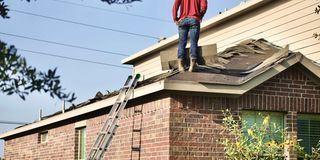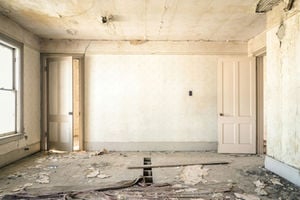
Assess the roofing materials for damage. PHOTO/UNSPLASH.COM
In the past, Kampala’s property market faced a rather unsettling issue involving some refugee tenants who allegedly buried deceased family members in the bungalows they were renting. One landlord, for instance, discovered human remains hidden beneath newly retiled floors in his property.
This grim revelation led to a widespread concern among landlords and prospective buyers, prompting many to engage house inspectors to ensure that properties were free from such disturbing violation today, while the particular issue of burial in living rooms is no longer a major concern, the importance of home inspections remains undiminished.
Whether you are considering purchasing a home, moving into a rental property, or reclaiming a property after an extended lease, conducting a thorough inspection is a wise and prudent measure.
A comprehensive home inspection should meticulously assess several critical elements of the property, including the foundation, roof, walls, electrical system, and plumbing system, among others. While renters may be inclined to check basic functionalities like whether the toilets flush or the electrical switches work, prospective buyers have a more substantial interest in ensuring the property’s overall condition and safety.
For a detailed and reliable inspection, enlisting the services of a qualified architect or structural engineer is highly recommended. According to architect Simon Peter Kazibwe, a thorough home inspection is essential for determining whether a house is fit for habitation and, if so, identifying any repairs or improvements needed to ensure its safety and functionality.
Structural Inspection According to experts, a structural inspection is arguably the most critical aspect of evaluating a property. Architect Simon Peter Kazibwe emphasises that the foundation should be one of the primary focuses during this assessment.
"One of the first things we examine is the foundation," Kazibwe explains. "We look for signs of cracks and settlement issues, which are crucial indicators of potential structural problems."
Foundation settlement refers to the downward movement of the ground or soil beneath a building, often due to changes in the stresses placed upon it.
This can occur when the soil compress[1]es or shifts under the weight of the structure, potentially leading to signifi[1]cant problems such as leaning or crack[1]ing of the building.
Kazibwe notes that foundation settlement can be exacerbated by various factors. For example, constructing a building in a poorly drained or excessively wet area without adequate waterproofing measures can lead to soil instability. Additionally, failing to adhere to proper construction standards and techniques can compromise the integrity of the foundation. This underscores the importance of ensuring that the foundation is built to withstand.
Roof
The roof is a vital component of any property, exposed continuously to the elements, including rain, sunlight, wind, and dew. Consequently, it requires a meticulous inspection to ensure its structural integrity and effectiveness.
During a roof inspection, the overall sturdiness of the roof should be assessed. Look for any signs of sagging or unevenness, which could indicate underlying structural problems. Checking for leaks is crucial, as water infiltration can cause significant damage to the interior of the home. Look for stains or damp spots on ceilings and walls, and address any leaks promptly to prevent further issues.
The condition of the nails and fasteners that hold the roofing materials in place should also be examined. Over time, these can become rusted or corroded, compromising the roof’s ability to remain secure. Ensuring that they are in good condition is essential for maintaining the roof’s effectiveness.
Assess the roofing materials for any damage. Broken or missing tiles, shingles, or panels should be noted, as these may require repair or replacement. Additionally, proper ventilation is essential for maintaining the roof’s health and preventing moisture build-up, so check for functioning ventilation systems.
Moss or algae growth on the roof should be evaluated as well. While not always a critical issue, excessive growth can contribute to roof deterioration and may need to be addressed.
Finally, inspect the rainwater gutters and downspouts to ensure they are clear of blockages and securely attached. Properly functioning gutters and downspouts are essential for directing rainwater away from the foundation and preventing water damage Walls When inspecting the walls of a property, a comprehensive evaluation goes beyond merely checking for cracks. According to Kazibwe, it is essential to also assess for signs of moisture, rot, and structural movement. Key indicators to watch for include sinking earth around the house, bubbling or peeling paint, and uneven or warped walls.
"A cracked wall is often the most visible sign of potential structural issues," Kazibwe notes. "Even minor cracks should not be dismissed lightly. They often signify underlying problems that could worsen over time. If you are considering purchasing the property, it's crucial to take these cracks into account and adjust your offer accordingly."
In addition to examining the walls themselves, it is important to inspect both the exterior and interior of the home for defects in windows and doors.
This includes checking the condition of the sealing products around glass panes and evaluating the functionality of shutters.
Plumbing systems
A thorough inspection of the plumbing involves checking for any damage to the piping, identifying potential leaks, and evaluating the overall condition of the system.
For older homes, plumbing systems often include metallic pipes that may be prone to rust, corrosion, or blockages, which can result in reduced water pressure. It is essential to have a skilled plumber involved in the inspection to thoroughly examine all components of the plumbing system, including the water heater, kitchen and bathroom sinks, and other fixtures.
"The key is to address any leaks in the plumbing system before they lead to moisture problems elsewhere in the building," advises Kazibwe. Preventing water from seeping into other areas is crucial to maintaining the property’s overall condition.
Electrical inspection Assess whether the existing wiring is suitable for the intended use of the
home. “Consider whether the house has previously served a different purpose, such as an office, and now you're planning to convert it into a residence. Offices typically use smaller appliances compared to those found in a home, such as stoves and washing machines. If the existing wiring was designed for lighter office equipment, it might not be adequate for the higher demands of home appliances. This mismatch can lead to overheating wires and potentially damage your appliances,” Kazibwe explains.
An electrical inspection is crucial for ensuring that the wiring and components of the electrical system are safe and capable of supporting the house hold's needs.
Check if the wiring is appropriately installed inside the walls. Exposed or improperly installed wiring can pose safety risks, especially in a home with children who might tamper with electrical components.
Inspect the main electrical panel or switchboard to ensure it is functioning correctly and can handle the electrical load required by the home
SAFETY
Architect Simon Peter Kazibwe stresses that for larger properties, it is essential to check safety and security features, including fire detectors, fire escape routes, and fire extinguishers. Additionally, the strength of railings on stairs and balconies should be assessed to ensure they are secure.
If significant structural issues are found such as severe cracks or water damage in the walls or foundation, the property may be deemed uninhabitable




